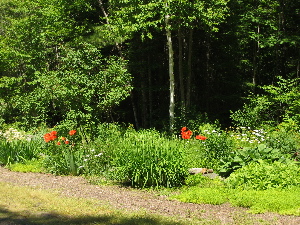FERTILIZER & LILACS
It's getting close to Lilac time! Although my garden is still tucked into frozen ground, I'm sure others of you are beginning to see lots of "green" around the garden. I have gotten a question about lilacs and how to treat them, so I thought I'd address it in a posting here.
My lilacs have swollen buds, but that's IT! How about yours?
The first thing that most people are thinking about is PRUNING! DON’T do it YET! Pruning on any flowering shrub should ONLY be done AFTER it has finished blooming. If you don’t wait, you’ll cut off your flowers! So, put this on the back burner.
Next is fertilizing. Here I can give you a little help. Try going to this link about fertilizer. It explains the numbers pretty clearly. I always try to simplify stuff like this, so I label the numbers by what I see on the plant “first, second, and seldom”.
The first thing you will see is the leaves. So that’s what the first number will help. It will “green up” the plant.
The second thing you see is the blooms. So the second number benefits the fruiting and seed manufacturing function of the plant.
The thing you seldom see is the roots, bulb, rhizome, etc. So the third number will beef up those critical parts of your plant.
The bottom line here is that:
• when you want to encourage leaf growth, as in grass, you want the first number to be HIGH.
• when you have a flowering plant, you want the second number to be high to encourage those blooms.
• when you want to encourage root health, as for bulbs, rhizomes, etc., cold-hardiness and general health you want the third number to be HIGH
This also means that at different times of the year, you might use different balances of fertilizer depending on what you want to encourage.
Remember these are pretty GENERAL statements.
As is usually the recommended procedure, you should get a SOIL TEST done. This will tell you exactly what you should add, and the quantities to boot!
So what to do NOW with your LILACS? I’d give them a bit of fertilizer with the second number higher than the others. Scratch it into the soil around the plant to the drip line. By the way, the drip line is where the plants leaves would drip when wet. That’s also about as far out as the roots would venture. It’s a good guide as to where to fertilize around a tree or shrub. If you have mulch around it, don’t worry about scraping it in, it’ll get where it needs to be after the next rain, and it won’t wash away as it would if left on bare ground.





2 Comments:
I live in Phoenix, AZ and am trying to find an answer to this question:
Will scorpions (bark scorpions)nest in Cedar Bark chips/mulch? I have an area between my house structure and block (property)dividing wall that I placed about 6 inches of cedar bark/mulch. Nothing grows in this area and with the cedar it looks nice and smells nice. Now I am wondering if I have created a breeding ground for scorpions?
I have called exterminators (4) in the area and nobody has the answer.
HELP!!!!!!!!
Thanks,
Joyce
Remember I'm not familiar with desert creatures, so I can't be more helpful. I'm surprised the exterminators don't know more.
Also, try contacting your Univ. Of Arizona Extension Service. They should be of tremendous help!
Hope this helps some.
Post a Comment
<< Home